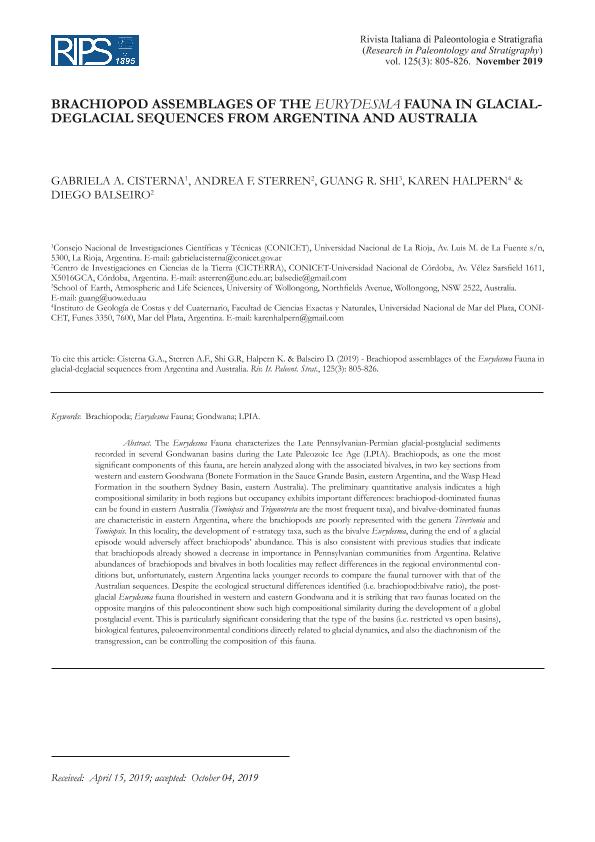Mostrar el registro sencillo del ítem
dc.contributor.author
Cisterna, Gabriela Adriana

dc.contributor.author
Sterren, Andrea Fabiana

dc.contributor.author
Shi, Guang, R.
dc.contributor.author
Halpern, Karen

dc.contributor.author
Balseiro, Diego

dc.date.available
2022-11-17T17:50:37Z
dc.date.issued
2019-10
dc.identifier.citation
Cisterna, Gabriela Adriana; Sterren, Andrea Fabiana; Shi, Guang, R. ; Halpern, Karen; Balseiro, Diego; Brachiopod assemblages of the Eurydesma fauna in glacial-deglacial sequences from Argentina and Australia; Università degli Studi di Milano; Rivista Italiana di Paleontologia e Stratigrafia; 125; 3; 10-2019; 805-826
dc.identifier.issn
0035-6883
dc.identifier.uri
http://hdl.handle.net/11336/178265
dc.description.abstract
The Eurydesma Fauna characterizes the Late Pennsylvanian-Permian glacial-postglacial sediments recorded in several Gondwanan basins during the Late Paleozoic Ice Age (LPIA). Brachiopods, as one the most significant components of this fauna, are herein analyzed along with the associated bivalves, in two key sections from western and eastern Gondwana (Bonete Formation in the Sauce Grande Basin, eastern Argentina, and the Wasp Head Formation in the southern Sydney Basin, eastern Australia). The preliminary quantitative analysis indicates a high compositional similarity in both regions but occupancy exhibits important differences: brachiopod-dominated faunas can be found in eastern Australia (Tomiopsis and Trigonotreta are the most frequent taxa), and bivalve-dominated faunas are characteristic in eastern Argentina, where the brachiopods are poorly represented with the genera Tivertonia and Tomiopsis. In this locality, the development of r-strategy taxa, such as the bivalve Eurydesma, during the end of a glacial episode would adversely affect brachiopods’ abundance. This is also consistent with previous studies that indicate that brachiopods already showed a decrease in importance in Pennsylvanian communities from Argentina. Relative abundances of brachiopods and bivalves in both localities may reflect differences in the regional environmental conditions but, unfortunately, eastern Argentina lacks younger records to compare the faunal turnover with that of the Australian sequences. Despite the ecological structural differences identified (i.e. brachiopod:bivalve ratio), the postglacial Eurydesma fauna flourished in western and eastern Gondwana and it is striking that two faunas located on the opposite margins of this paleocontinent show such high compositional similarity during the development of a global postglacial event. This is particularly significant considering that the type of the basins (i.e. restricted vs open basins), biological features, paleoenvironmental conditions directly related to glacial dynamics, and also the diachronism of the transgression, can be controlling the composition of this fauna.
dc.format
application/pdf
dc.language.iso
eng
dc.publisher
Università degli Studi di Milano

dc.rights
info:eu-repo/semantics/openAccess
dc.rights.uri
https://creativecommons.org/licenses/by-sa/2.5/ar/
dc.subject
BRACHIOPODA
dc.subject
EURYDESMA FAUNA
dc.subject
GONDWANA
dc.subject
LPIA
dc.subject.classification
Paleontología

dc.subject.classification
Ciencias de la Tierra y relacionadas con el Medio Ambiente

dc.subject.classification
CIENCIAS NATURALES Y EXACTAS

dc.title
Brachiopod assemblages of the Eurydesma fauna in glacial-deglacial sequences from Argentina and Australia
dc.type
info:eu-repo/semantics/article
dc.type
info:ar-repo/semantics/artículo
dc.type
info:eu-repo/semantics/publishedVersion
dc.date.updated
2022-11-15T14:19:19Z
dc.journal.volume
125
dc.journal.number
3
dc.journal.pagination
805-826
dc.journal.pais
Italia

dc.journal.ciudad
Milan, Italia
dc.description.fil
Fil: Cisterna, Gabriela Adriana. Universidad Nacional de la Rioja. Museo de Cs. Naturales; Argentina. Consejo Nacional de Investigaciones Científicas y Técnicas; Argentina
dc.description.fil
Fil: Sterren, Andrea Fabiana. Consejo Nacional de Investigaciones Científicas y Técnicas. Centro Científico Tecnológico Conicet - Córdoba. Centro de Investigaciones en Ciencias de la Tierra. Universidad Nacional de Córdoba. Facultad de Ciencias Exactas Físicas y Naturales. Centro de Investigaciones en Ciencias de la Tierra; Argentina
dc.description.fil
Fil: Shi, Guang, R.. University Of Wollongong. School Of Earth And Enviromental Sciences; Australia
dc.description.fil
Fil: Halpern, Karen. Universidad Nacional de Mar del Plata. Facultad de Ciencias Exactas y Naturales. Instituto de Geología de Costas y del Cuaternario. Provincia de Buenos Aires. Gobernación. Comisión de Investigaciones Científicas. Instituto de Geología de Costas y del Cuaternario; Argentina
dc.description.fil
Fil: Balseiro, Diego. Consejo Nacional de Investigaciones Científicas y Técnicas. Centro Científico Tecnológico Conicet - Córdoba. Centro de Investigaciones en Ciencias de la Tierra. Universidad Nacional de Córdoba. Facultad de Ciencias Exactas Físicas y Naturales. Centro de Investigaciones en Ciencias de la Tierra; Argentina
dc.journal.title
Rivista Italiana di Paleontologia e Stratigrafia

dc.relation.alternativeid
info:eu-repo/semantics/altIdentifier/doi/http://dx.doi.org/10.13130/2039-4942/12249
Archivos asociados
